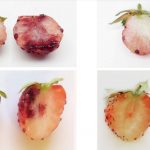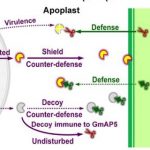Plant Science Research Weekly: November 6, 2020
Review: Optogenetics in plants

Optogenetics is the process by which light can modify cellular behavior, through the action of light-sensitive proteins or other molecules. In many respects, optogenetics seems more like science fiction than reality; the realization that neural activity in the brain can be altered through pulses of light certainly seems ripe for abuse. However, like any technology, it also has beneficial applications, and those in plants are the focus of this review by Christie and Zurbriggen. They first note that plants produce many light-sensitive proteins (e.g., phytochromes, cryptochromes) that enrich the optogenetic toolbox. However, the presence of these endogenous proteins also complicates optogenetic applications, so several approaches are being used to engineer optogenetic modules with specific outcomes. A few of these are described here, including the use of a blue-light activated ion channel that enhances stomatal responsiveness and leads to greater biomass accumulation under fluctuating light conditions. Stay tuned, as the potential applications of optogenetics in plants (and people!) are just beginning to be realized. (Summary by Mary Williams @PlantTeaching) New Phytol. 10.1111/nph.17008
The genomic and transcriptomic foundations of viviparous seed development in mangroves
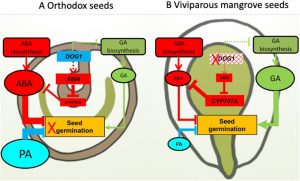
Some mangrove species are viviparous, meaning their seeds germinate while still attached to the mother plant. This behavior is thought to facilitate seedling establishment in the tropical and subtropical intertidal zones they inhabit. However, the genetic and molecular mechanism behind it remains to be described. Here, Qiao and colleagues compare the genome and seed transcriptomic profile of viviparous mangroves and their non-viviparous relatives to look for the potential mechanisms underpinning this phenomenon. Abscisic acid (ABA) and proanthocyanidin (PA) biosynthesis genes were downregulated towards the end of the development of viviparous species seeds. The same trend was observed for gibberellic acid (GA) negative transduction genes. Considering that ABA and PA inhibit germination and GA promotes its, this transcriptomic profile supports why viviparous seeds can germinate immediately after being fully developed. Also, viviparous mangroves lack or have a nonfunctional copy of the DELAY OF GERMINATION1 (DOG1) gene, known for promoting dormancy by inhibiting ABA degradation. Therefore, this research provides an exciting starting point towards unraveling the molecular mechanism responsible for viviparous mangroves. (Summary by Carlos A. Ordóñez-Parra @caordonezparra) bioRxiv 10.1101/2020.10.19.346163
MSH1-induced heritable enhanced growth vigor through grafting is associated with the RdDM pathway in plants
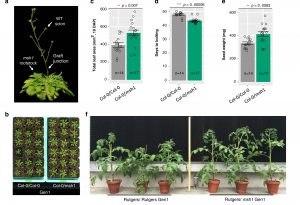
The ability of plants to adapt to diverse environments and environmental conditions has been attributed to phenotypic plasticity mediated by genetic and epigenetic changes. Through grafting experiments, small RNA has been shown to be a mobile molecule that can be transmitted long-distance via the vascular system. While several studies have demonstrated the effect of this mobility at the recipient tissue, knowledge about effects in the graft progeny remain elusive. The nuclear-encoded MutS HOMOLOGUE 1 (MSH1) gene controls organelle genome stability, and when mutated leads to graft-transmissible epigenetic changes; wildtype plants grafted on msh1 rootstock display enhanced growth vigor and seed yield in the graft progeny. Kundariya et al. explored the relationship between this heritable enhanced vigor and epigenetic processes in tomato and arabidopsis. Transcriptomic analysis in graft progenies showed differential gene expression in stress and hormone pathways in both species, and bisulfite sequencing showed that graft progeny from msh1 rootstock undergoes methylation repatterning. To identify phenotype-related differentially methylated genes, network-based enrichment (NBE) analysis was performed. Phytohormone signaling network was enriched, with auxin as the most significant. Growth enhancement in the root in msh1 was subsequently shown to be associated with auxin transport. The observed heritable growth enhancement through grafting in msh1 was lost in the dcl2,3,4 mutant, suggesting that this phenomenon is associated with the RdDM pathway. (Summary by Toluwase Olukayode @toluxylic) Nature Comms. 10.1038/s41467-020-19140-x
Functionally overlapping but molecularly distinct TGN subdomains of two Epsin-like proteins
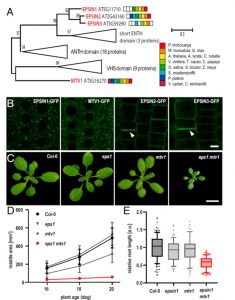
The trans-Golgi networks (TGN) is a major protein sorting station involved in trafficking or recycling of endosomal materials. This busiest hub in the cell has at least four important pathways including the anterograde routes of secretory, recycling, vacuolar transport and retrograde endocytic pathways. At molecular level, it remains unclear how sorting of cargo and distribution into different vesicles are controlled. Heinze et al. identified two Arabidopsis Epsin-like proteins, EPSIN1 and MTV1, localized in speckles resembling endosomal structures at the TGN. The single mutants of these genes do not show drastic phenotypes but the double mutant eps1mtv1 exhibited dwarf phenotype, suggesting their functional redundancy. EPSIN1 and MTV1 contribute to the vacuolar transport and a subset of secretory cargo independently of the TGN protein ECHIDNA. However, these two proteins are not involved endocytic or recycling pathways. Interestingly, EPSIN1 and MTV1 do not colocalize and a large distance was revealed between them, indicating their presence at two distinct TGN subdomains. EPSIN1 interacts and colocalizes with AP-1 (Adaptor protein), whereas MTV1 acts in the same pathway as AP-4 and is recruited by it. Overall, these two Epsin-like proteins are phenotypically and functionally overlapping, but the subcellular localization and molecular interaction are distinct. (Summary by Min May Wong @wongminmay) PNAS 10.1073/pnas.2004822117
Phosphorylation-dependent sub-functionalization of the calcium-dependent protein kinase CPK28
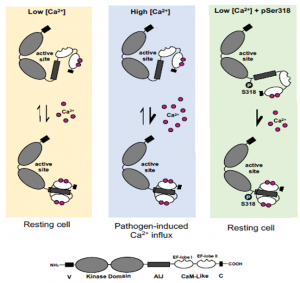
Calcium-dependent protein kinases (CPKs) form an important class of sensor-responder proteins that bind Ca2+ to ‘sense’ intracellular Ca2+ levels, and ‘respond’ by phosphorylating target proteins. CPK28 has distinct roles in growth and defense. To analyze the importance of Ca2+ in fine-tuning CPK28 function, Bredow and colleagues identified a single phosphorylation site, serine (Ser) 318, as vital for separating its dual functions in regulating immune responses and stem elongation. The authors found that mutating Ser318 into a non-phosphorylatable form leaves it unable to complement the immune response phenotype in a cpk28 mutant, indicating that Ser318 phosphorylation is necessary for immune response. In agreement, they observed that another kinase, BIK1, can phosphorylate CPK28 on Ser318 to regulate immune responses. Importantly, the authors found this site critical for phosphorylation at physiological concentrations of Ca2+, which alters the conformation of CPK28. Together with other results, they conclude that at physiological Ca2+ levels, phosphorylation of Ser318, which is conserved among a group of CPKs, is essential for “priming” the protein to sense further increase in cellular Ca2+ following a pathogen attack. (Summary by Pavithran Narayanan @pavi_narayanan) bioRxiv 10.1101/2020.10.16.338442v1
Ethylene independent functions of ACC in Marchantia polymorpha

Ethylene is synthesized from 1-Aminocyclopropane carboxylic acid (ACC), and ACC has long been used as a substitute to induce ethylene responses. In a new study, Li and colleagues show that ACC functions as a stand-alone signaling molecule in the liverwort Marchantia. While treatment with ethylene gas increased overall vegetative growth by increasing cell division and expansion, ACC treatment inhibited the growth by suppressing cell division. Contrary to observations in other plants like Arabidopsis thaliana, treatment with even high amounts of ACC did not result in significant ethylene production in Marchantia. Further, plants mutated in genes encoding ACS proteins – enzymes that produce ACC from its precursor – was compromised in ethylene production only by a thin margin, suggesting a large part of the hormone might be produced from non-ACC precursor(s). Thus, this report suggests divergent and nearly opposite roles for ACC and ethylene in non-seed plants and adds to our understanding of evolution of ethylene signaling. (Summary by Pavithran Narayanan @pavi_narayanan) Nature Plants 10.1038/s41477-020-00784-y
Ethylene signaling mediates host invasion by parasitic plants

Parasitic plants cause agricultural devastation across the globe, yet the molecular basis of their parasitism is largely enigmatic. They grapple and intrude into the host roots with an organ called the haustorium. Haustoria formation is induced upon recognition of host-derived haustorium-inducing factors (HIFs), including quinones and phenolics, but HIFs are not sufficient to complete haustoria differentiation and development; HIF-induced haustoria formation is halted when the host is not available. To identify missing factors that determine the fate of haustoria cells, Cui et al. conducted a forward genetic screening in the model parasitic plant Phtheirospermum japonicum. Successful host invasion depends upon switching off cell proliferation at the haustorium apex. The authors found that genes involved in ethylene signaling are required for timely termination of haustorium growth but are dispensable for early haustorium initiation. They further showed that, P. japonicum was less invasive to host Arabidopsis mutants with no or excessive ethylene production, suggesting that host-derived ethylene may play an important role in successful invasion of the parasite. The authors suggest that the HIFs might indicate that a host is near, causing the initiation of haustorium formation, and host-induced ethylene indicates that the haustorium has reached its target, causing the haustorium to stop elongating. (Summary by Tatsuya Nobori @nobolly) Science Advances 10.1126/sciadv.abc2385
WUSCHEL triggers innate antiviral immunity in plant stem cells
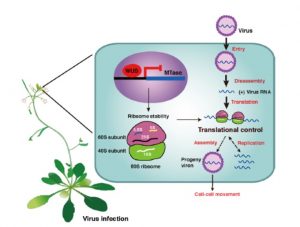
Meristem culture is widely used as a technique for plant propagation because meristems are usually virus-free, even in systemically infected plants. It has long been assumed that viruses are unable to enter the cells of the meristem due to the meristem’s lack of vascular connections to the plant. Here, Wu et al. identify an active meristem-based viral suppression system that involves the meristem-specific transcription factor WUSCHEL (WUS). WUS maintains the stem-cell fate of the meristem and is expressed in a very specific domain. The authors noted that in virus-infected plants, WUS-expressing cells are resistant to viral invasion, even in genetic backgrounds that alter the normal WUS expression pattern, suggesting that WUS somehow suppresses viral infection. Additional studies revealed that WUS acts by repressing expression of an RNA methyltransferase that is necessary for rRNA processing and therefore ribosome assembly, leading to a global decrease in protein synthesis in these cells. Because viruses depend on the host machinery for protein synthesis, with their repressed protein-synthesis machinery WUS-expressing cells are inherently more resistant to viruses. (Summary by Mary Williams @PlantTeaching) Science 10.1126/science.abb7360
N-glycosylation shields Phytophthora sojae apoplastic effector PsXEG1 from a specific host aspartic protease
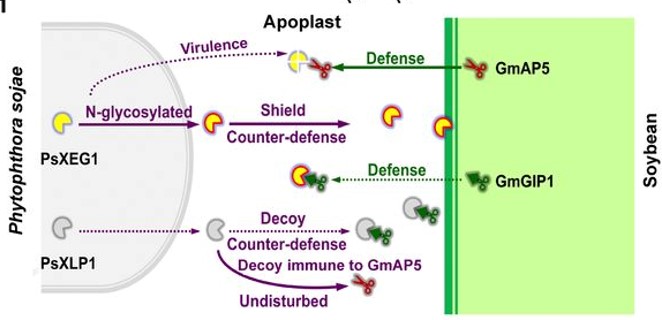
Physicists say “for every reaction there is an equal and opposite reaction,” an expression that applies to the interactions between plants and pathogens as well. Here, Xia et al. have uncovered another layer in the “arms race” between soybeans and the oomycete pathogen Phytophthora sojae. PsXEG1 is an oomycete-produced plant cell wall-degrading xyloglucan-specific endoglucanase. Previous studies have identified a specific inhibitor of PsXEG1 enzymatic activity, produced by the plant cell to suppress the pathogen. Here, the authors have identified another plant strategy, the secretion of a very specific protease that targets PsXEG1. Not to be outdone, the pathogen blocks the plant protease by post-translationally modifying PsXEG1 through addition of a glycosyl group to an Asn residue (N-glycosylation), and this modification is necessary for the pathogen’s full virulence. Evolution truly is a wonderous process. (Summary by Mary Williams @PlantTeaching) Proc. Natl. Acad. Sci. USA 10.1073/pnas.2012149117


